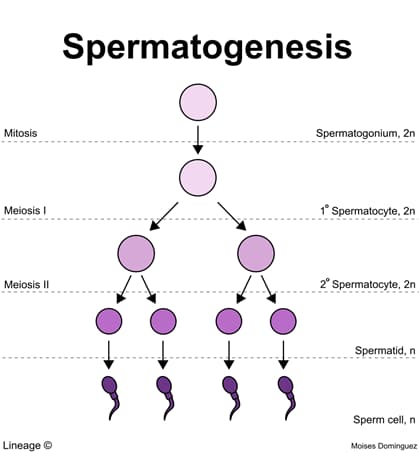If you’ve ever wondered what is the spermatogenesis, you’re not alone. Spermatogenesis is a fundamental biological process responsible for the production of male gametes or sperm cells. It takes place in the seminiferous tubules of the testes and plays a crucial role in male fertility and reproduction.

Introduction
- A process by which spermatogonia develop into spermatozoa
- begins at puberty
- requires 64 days (approximately 2 months)
- Broken down into
- spermatogenesis
- the formation of spermatids from spermatogenic cells
- spermiogenesis
- spermatogenesis
- the process of spermatids maturing into mature sperm
Spermatogenesis
- Spermatogenic cells are organized in poorly defined layers of progressive development between adjacent Sertoli cells in seminiferous tubules
- Spermatogonia (2N), most immature spermatogenic cells, rest on basal lamina
- spermatogonia occupy basal compartment in seminiferous tubules
- Spermatogonia (2N) divide by mitosis
- produces primary spermatocytes (2N)
- Primary spermatocytes (2N) replicate DNA (4N)
- primary spermatocytes move across Sertoli cell – Sertoli cell junctional complexes into luminal compartment in seminiferous tubules
- Primary spermatocytes (4N) divide by meiosis I
- produces 2 haploid secondary spermatocytes (2N)
- nondisjunction at this stage can lead to Klinefelter syndrome
- Secondary spermatocytes (2N) divide by meiosis II
- produces 4 haploid spermatids (1N)
Spermiogenesis
- Spermatids (1N) differentiate into spermatozoa (1N) by an extensive remodeling process
- Loss of cytoplasm, gain of acrosomal cap, and flagellum (tail)
- acrosomal cap develops via Golgi apparatus
- flagellum (tail) develops via centrioles
Spermatozoa

Head
- acrosomal cap and nucleus
- Tail
- neck
- middle piece
- mitochondria provide energy for movement of flagellum (tail)
- sperm motility
- mitochondria provide energy for movement of flagellum (tail)
- principal piece
- end piece
- Nutrition
- spermatozoa feed on fructose
So, what is the spermatogenesis in more detail? It is the process through which diploid spermatogonia (male germ cells) undergo several stages of division and transformation to form mature, motile spermatozoa. This complex transformation involves three primary phases – mitosis, meiosis, and spermiogenesis.
The Three Phases of Spermatogenesis:
- Mitosis: It begins when spermatogonia, located near the basement membrane of the seminiferous tubules, divide mitotically. Some remain as stem cells to maintain the process, while others become primary spermatocytes.
- Meiosis: Each primary spermatocyte undergoes meiosis I to form two secondary spermatocytes, which then proceed through meiosis II to produce spermatids (haploid cells).
- Spermiogenesis: This final phase transforms non-motile spermatids into mature sperm cells with distinct head, midpiece, and tail regions.
Now, if you’re still asking what is the spermatogenesis, it’s the highly organized series of events that ensures continuous sperm production throughout a male’s reproductive life. This process is regulated by hormones like testosterone, FSH (Follicle-Stimulating Hormone), and LH (Luteinizing Hormone).
Another way to understand what is the spermatogenesis is to recognize its importance in maintaining genetic diversity. Since it involves meiosis, it ensures that sperm cells carry only half the genetic material, enabling proper fusion with the egg during fertilization.
For students or biology enthusiasts curious about what is the spermatogenesis, it’s essential to grasp that it not only supports reproduction but also ensures the transmission of genetic information to the next generation. Disruptions in this process can lead to infertility or genetic disorders.
In summary, what is the spermatogenesis? It’s the remarkable biological journey that transforms ordinary germ cells into highly specialized sperm cells, ensuring the miracle of life continues.



